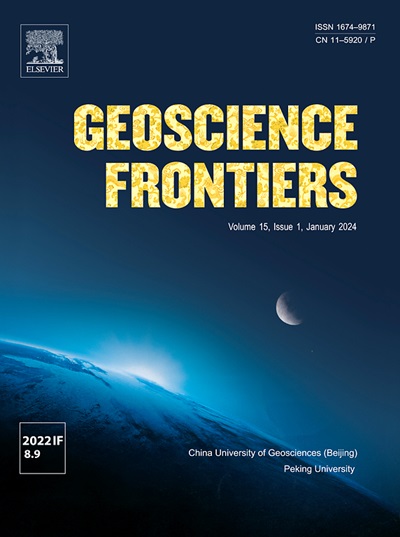伊朗和安纳托利亚“卡多米亚”岩浆活动的非弧背景
IF 8.5
1区 地球科学
Q1 GEOSCIENCES, MULTIDISCIPLINARY
引用次数: 0
摘要
确定板块边界的类型和位置是古地理重建的关键。冈瓦纳北缘在新元古代晚期至早古生代(即阿瓦洛尼亚-卡多米亚造山带)的大部分时间内被推断为一个辐合的安第斯式板块边缘,这主要是基于与弧相关的地球化学亲缘的火成岩的存在。然而,阿拉伯板块边缘的主要部分包括埃迪卡拉纪-中寒武纪(约600-500 Ma)双峰火成岩,更典型的大陆裂谷环境,这导致了对岩浆构造作用的模糊和矛盾的解释。本文采用另一种方法,通过研究伊朗、安纳托利亚和阿拉伯板块与约600-500 Ma岩浆活动同时发育的沉积盆地的演化,来研究NMG的构造背景。该段埃迪卡拉系—中寒武统由横向连续的硅屑层序和碳酸盐岩层序组成,在全区范围内具有广泛的相关性。从近端(阿拉伯板块)到远端(伊朗和安纳托利亚),古海流方向与北东方向一致,碎屑沉积物粒度减小,表明盆地地形相对平坦,向北向东深化。伊朗埃迪卡拉纪—中寒武世硅屑地层中新发现的碎屑锆石(n = 2870)和磷灰石(n = 1178) U-Pb年龄大多在600 Ma以上。碎屑磷灰石微量元素组成表明,碎屑磷灰石主要来源于ⅰ型花岗质和基性火成岩、低变质岩和高变质岩,少量来源于超基性岩。结合已公布的安纳托利亚和阿拉伯板块相关地层碎屑锆石U-Pb年龄数据,表明原有的阿拉伯-努比亚盾是主要的锆石来源。重要的是,碎屑锆石和磷灰石颗粒与年龄<;600 Ma在这些地层中很少见,表明它们几乎没有受到同时期埃迪卡拉-中寒武纪(约600 - 500 Ma)火成岩的影响。我们认为,约600-500 Ma火成岩的沉积物贡献非常小,这与认为在NMG的这一段发育大型安第斯式岩浆弧的构造模型相矛盾。将这些沉积记录的约束与伊朗和安纳托利亚约600-500 Ma火成岩的地球化学数据相结合,有利于形成一个伸展大陆边缘环境,这可能与冈瓦纳组合后埃迪卡拉-寒武纪的逃离构造或碰撞后松弛有关。本文章由计算机程序翻译,如有差异,请以英文原文为准。

Non-arc setting for “Cadomian” magmatism in Iran and Anatolia
Establishing the type and position of plate boundaries is crucial for paleogeographic reconstructions. The northern margin of Gondwana (NMG) is inferred to have been a convergent, Andean-style, plate margin for much the late Neoproterozoic to early Paleozoic (i.e., the Avalonian-Cadomian Orogen), based largely on the presence of igneous rocks with arc-related geochemical affinities. However, a major segment of the margin that fringed the Arabian Plate includes bimodal Ediacaran–middle Cambrian (ca. 600–500 Ma) igneous rocks, more typical of continental rift settings, which has led to ambiguous and contradictory interpretations of magma tectonogenesis. Here, we employ an alternative approach to investigate the tectonic setting of the NMG by studying the evolution of sedimentary basins that developed in Iran, Anatolia, and the Arabian Plate simultaneously with the ca. 600–500 Ma magmatism. The Ediacaran–middle Cambrian successions in this segment of the NMG consist of laterally continuous siliciclastic and carbonate sequences, which have been broadly correlated across the region. The consistent northward and eastward paleocurrent directions and decrease in clastic sediment grain-size from proximal (the Arabian Plate) to distal (Iran and Anatolia) successions suggest a northward and eastward deepening basin with relatively flat topography. The new detrital zircon (n = 2870) and apatite (n = 1178) U-Pb ages from the Ediacaran–middle Cambrian siliciclastic strata of Iran are mostly older than 600 Ma. Detrital apatite trace element compositions indicate that most grains are sourced from I-type granitoids and mafic igneous rocks, low- and high-grade metamorphic rocks, with a minority from ultramafic rocks. Together with published detrital zircon U-Pb age data from correlative strata in Anatolia and the Arabian Plate, these data suggest the pre-existing Arabian-Nubian Shield as the main source. Importantly, detrital zircon and apatite grains with ages < 600 Ma are rare in these strata, suggesting that they received little input from contemporaneous Ediacaran–middle Cambrian (ca. 600–500 Ma) igneous rocks. We suggest that the very small sediment contribution from the ca. 600–500 Ma igneous rocks argues against the tectonic model that considers the development of a large Andean-style magmatic arc at this segment of the NMG. Integrating these constraints from the sedimentary record with geochemical data from the ca. 600–500 Ma igneous rocks in Iran and Anatolia favors an extensional continental margin setting that may be related to escape tectonics or post-collisional relaxation during Ediacaran–Cambrian following Gondwana assembly.
求助全文
通过发布文献求助,成功后即可免费获取论文全文。
去求助
来源期刊

Geoscience frontiers
Earth and Planetary Sciences-General Earth and Planetary Sciences
CiteScore
17.80
自引率
3.40%
发文量
147
审稿时长
35 days
期刊介绍:
Geoscience Frontiers (GSF) is the Journal of China University of Geosciences (Beijing) and Peking University. It publishes peer-reviewed research articles and reviews in interdisciplinary fields of Earth and Planetary Sciences. GSF covers various research areas including petrology and geochemistry, lithospheric architecture and mantle dynamics, global tectonics, economic geology and fuel exploration, geophysics, stratigraphy and paleontology, environmental and engineering geology, astrogeology, and the nexus of resources-energy-emissions-climate under Sustainable Development Goals. The journal aims to bridge innovative, provocative, and challenging concepts and models in these fields, providing insights on correlations and evolution.
 求助内容:
求助内容: 应助结果提醒方式:
应助结果提醒方式:


